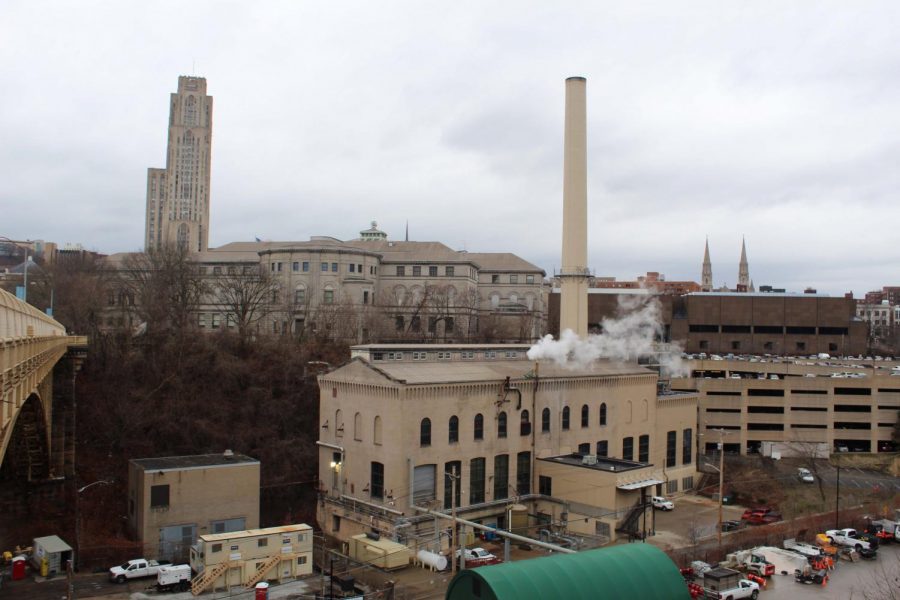Bellefield Boiler: A 113-year-old ‘Cloud Factory’
Carolyn Pallof | Staff Photographer
The Bellefield Boiler Plant is located behind the Carnegie Museums on Boundary Street, and generates steam to heat most of the major buildings in Oakland.
February 6, 2020
The Bellefield Boiler Plant has pumped out a steady flow of cloud-like exhaust from a tall stack tucked behind the Carnegie Museums for 113 years.
This little-known “Cloud Factory,” as Pitt alumnus Michael Chabon nicknames it in his 1988 novel “The Mysteries of Pittsburgh,” generates steam to heat most of the major buildings in Oakland.
The Bellefield Boiler Plant, tucked in a valley on Boundary Street below a Schenley Drive bridge, was built in 1907. The building provides heat for Pitt, Carnegie Mellon University, the Carnegie Museums and Library, Phipps Conservatory and UPMC’s Oakland-based hospitals.
Greg Paulowski, an engineer who has worked at the plant for 27 years, explained that when you get into the nitty-gritty detail of the steam generation process, it can appear somewhat complicated. But he said the process, which generates upwards of 400,000 pounds of steam per hour, is actually quite simple when you break it down.
“You take City water, put it into a pressurized vessel and heat it up. It becomes steam and is forced through piping,” Paulowski said. “The hot steam can be used for heating or power generation. Then, hopefully, you capture and reuse all your components — mainly water and some chemicals.”
The plant, housed in a large building designed by the same architects who designed the Carnegie Library, contains six boilers that run 24 hours a day, seven days a week, and emits exhaust from one large smokestack.
Bellefield currently utilizes natural gas, provided by Dominion Energy and transported by Peoples Gas, as fuel for the combustion that heats the water into steam. But from 1907 to 2009, the plant used coal as fuel for combustion, which Paulowski said was “very labor intensive.”
“It was dumped out of train cars and onto a conveyor,” Paulowski said. “There were guys who had to make sure it didn’t get stuck, they had to shovel the coals that fell and didn’t hit [the collection bin] perfectly.”
Paulowski added that during the winter, the coal cars froze over, requiring manual labor to unload them.
“The guys had steam guns and used them inside the cars,” Paulowski said. “It was very physical and dangerous.”
Although Bellefield had plans already in place, the switch from coal to natural gas was spurred by a February 2009 consent order issued by the Allegheny County Health Department. The transition aimed to reduce the amount of carbon, sulfur dioxide and particulate emissions.
Nowadays, Bellefield’s employees pride themselves on following regulations and staying within pollution limits.
“We are very cautious and very safe. We have a safety committee. We have an intense reporting system, and if we ever violate or pollute they would know it,” Paulowski said. “We can’t cover up anything — it is all data produced on a computer.”
Around the same time of the fuel switch, Pitt built the Carrillo Steam Plant on upper campus behind Trees Hall. Carrillo, from its inception, has always used natural gas as fuel.
Paulowski said the second plant was needed due to Pitt’s expansion over the years, and the resulting higher demand for steam in Oakland.
Rick Testa, the Bellefield plant’s foreman, said the plant’s energy efficiency is one of the many reasons it will stay operational for years to come.
“You don’t have to pump the steam uphill, the pressure carries it all the way up,” Testa said. “It is also a low maintenance production since the plant switched to natural gas.”
The plant is more than just a building with machinery that produces steam — it also has a rich history in Oakland. Jason Dignon, the pump man at Bellefield, said he is especially intrigued by this history.
“I like history, so I am fascinated by the generations of engineers that have come before us — hundreds of guys have considered this their home way back when,” Dignon said. “As much as Oakland changes, the one constant landmark here, I think, is Bellefield.”
Dignon said one of his favorite pieces of history at the plant is built directly into its structure.
“We have a giant piece of steel here in the building that is stamped with Carnegie,” Dignon said. “That steel predates U.S. Steel.”
Some passersby on the Schenley Bridge towering over Boundary Street may stop to admire the creation of clouds from the historic Bellefield Boiler Plant. But to many Oakland residents, the plant will likely remain unappreciated because it is hidden from view.
Dignon said the plant is so little known that he gets some strange looks when he tells people what he does.
“I never really met anyone that knew the plant was here,” Dignon said, “When I try to describe what I do and where I do it, no one has any idea. It’s like the hidden gem of Oakland.”








